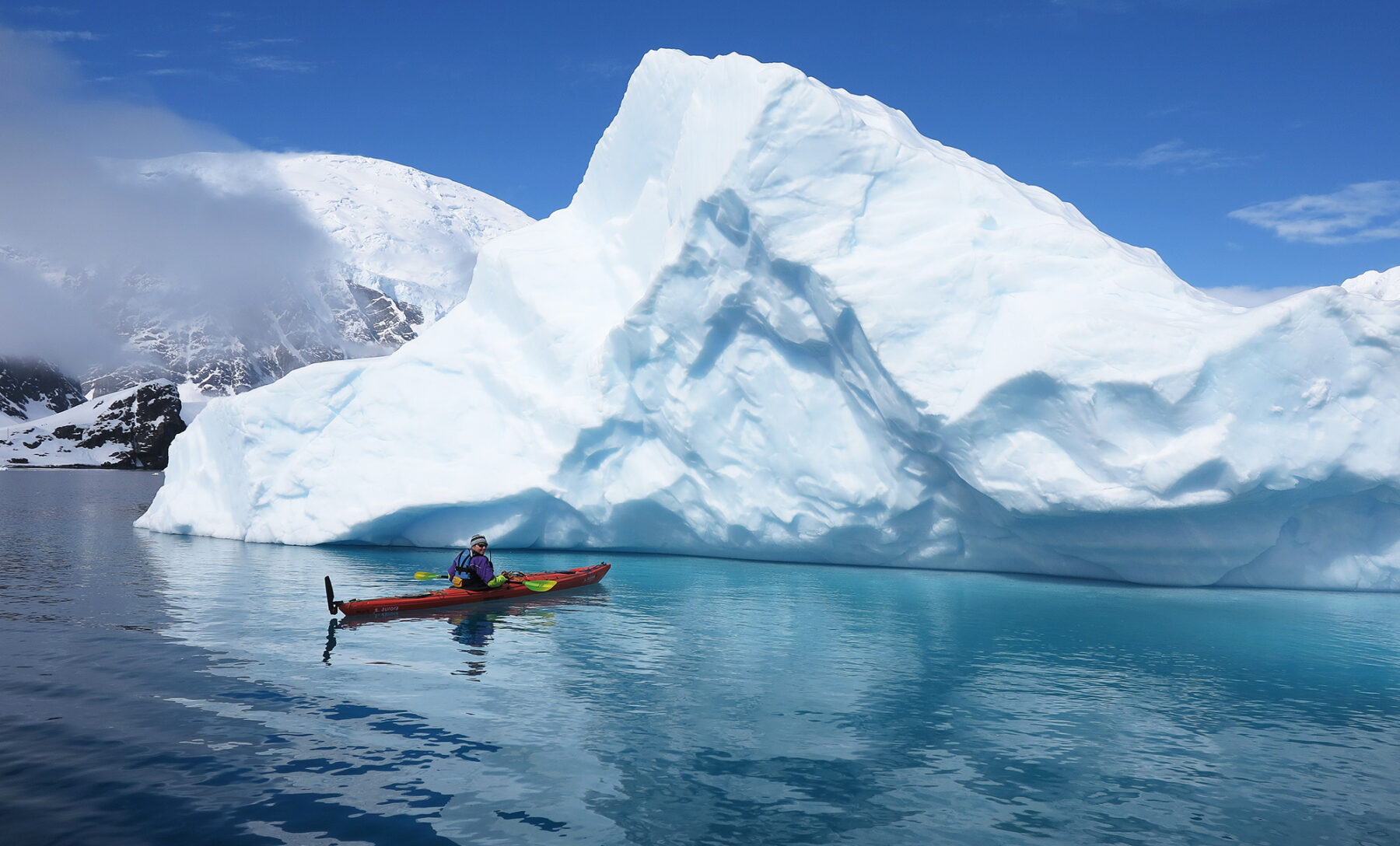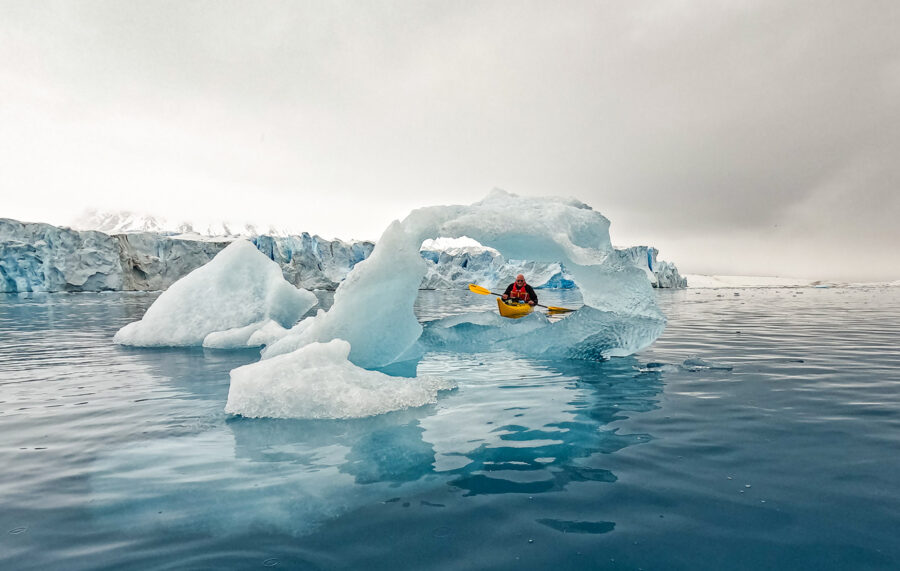Here’s a scary fact about icebergs: no, not the one about 85 per cent of them being underwater, although that is hard to comprehend when you see them towering above your insignificant plastic craft like a frozen tsunami. No, the scarier thing is that they can flip completely over without warning, crushing, or sucking under anything that happens to be near them at the time. They do this because as they slowly melt, their weight distribution changes, and at some point, the tiniest fraction of thaw will upset their delicate balance, leading to a literal tipping point. When kayaking in Antarctica and that happens, you do not want to be in the vicinity.
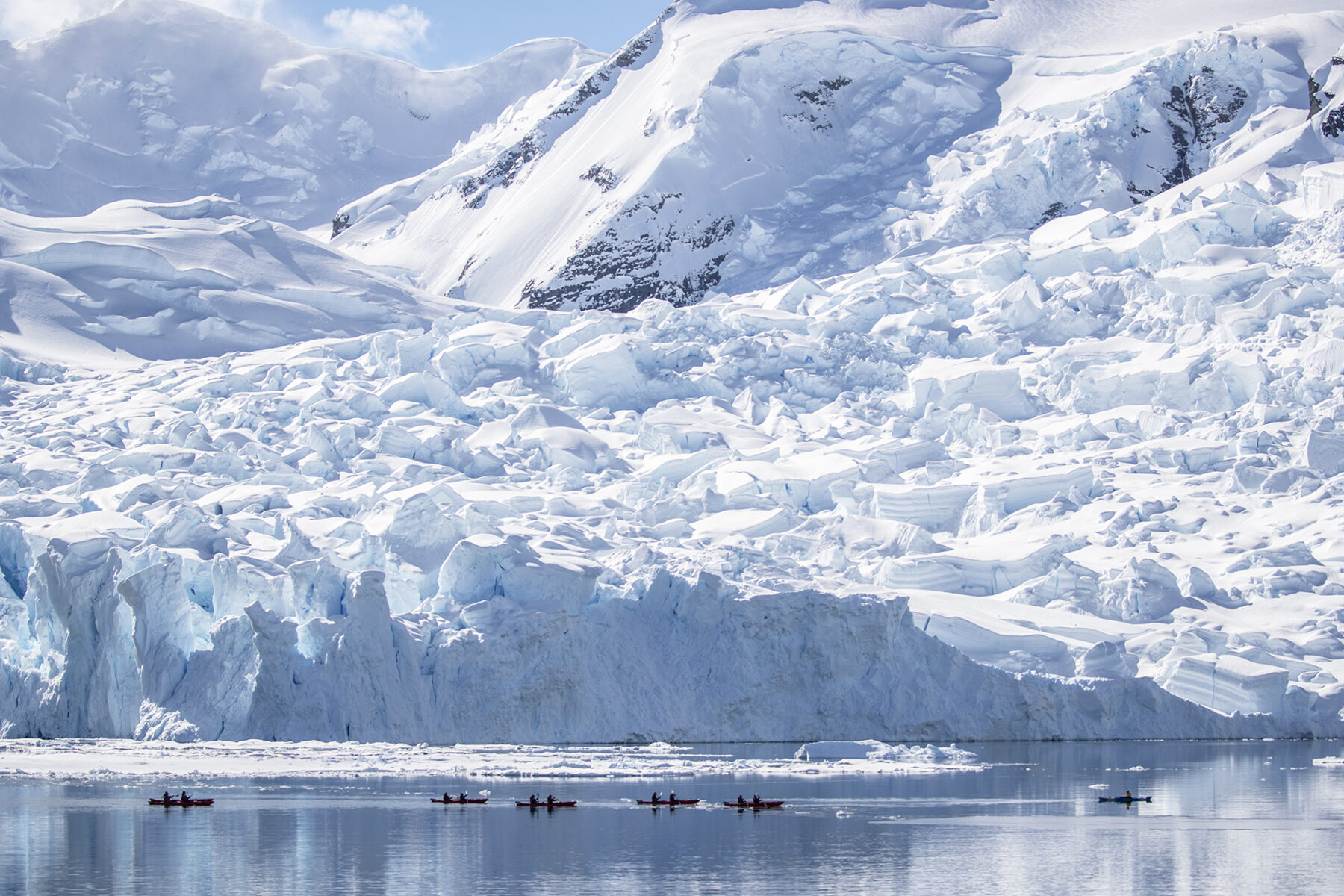
This is not something I saw outlined in the brochure (and certainly not something I’d want my mum to know), so rather than penguins and seals and whales, what I’m mainly thinking about whenever we paddle past a whopper of a ’berg is the infinitesimal possibility that at any second, I could be a Dan Smoothie. It doesn’t help when Michael, head kayaking guide, relates the time he heard one ‘the size of a shopping mall’ start to revolve behind him. “No point,” he replies when I ask if he’d tried to paddle away as fast as possible. “The only thing you can do is turn around, hope it’s not your time to go and enjoy the spectacle, because it might be the last thing you’re ever going to see.”
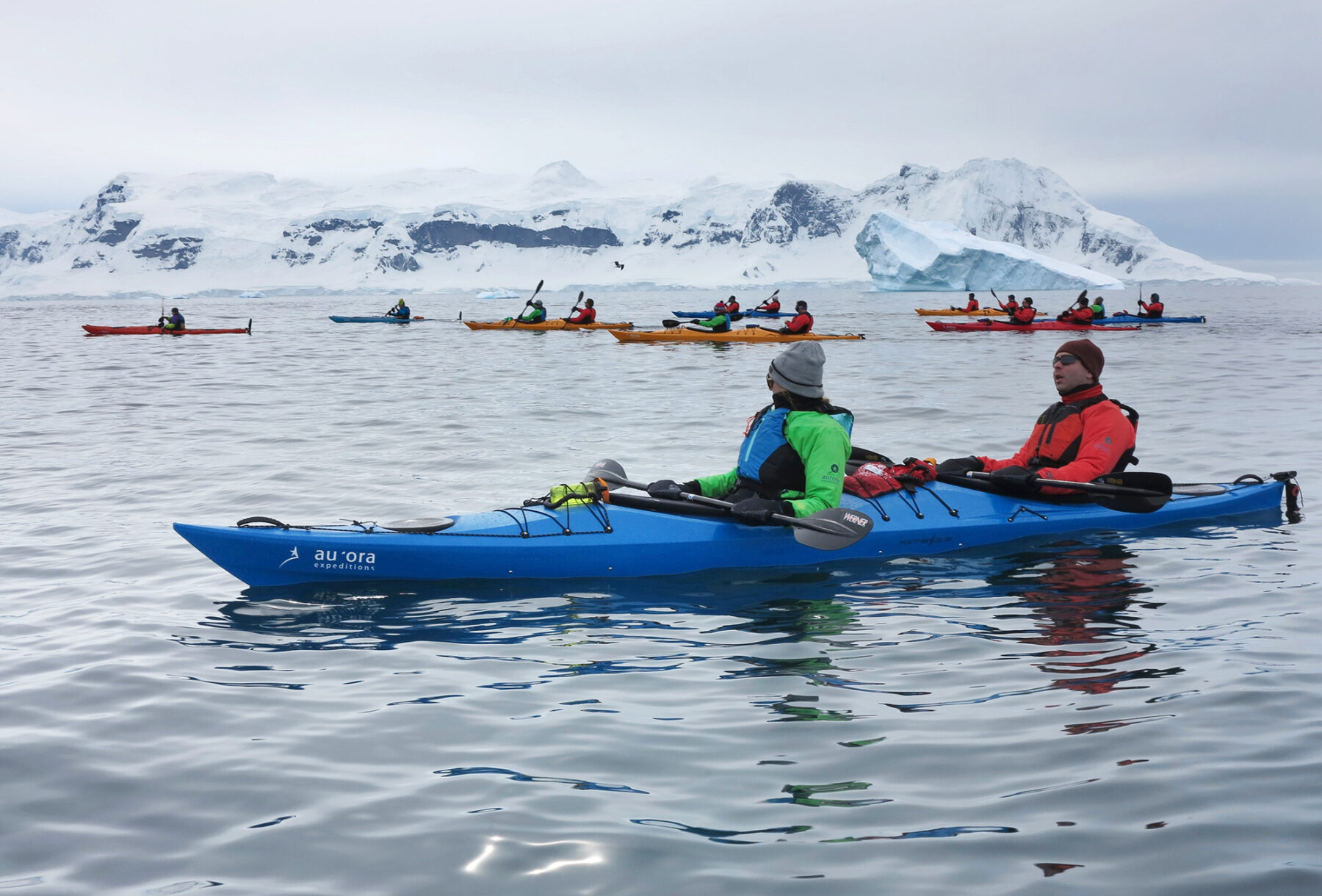
To their credit, Michael and the other expedition guides don’t allow us near any of the building-sized icebergs, only the truck-sized ones (15 per cent portion) and there’s no denying the thrill of being close enough to one of those icy behemoths to peer into its sapphire heart. This is precisely what I’d pictured on putting my hand up for Aurora Expeditions’ kayaking programme, an add-on to its expedition-style Antarctic cruise.
A kayaking in Antarctica dream come true
On the M/V Greg Mortimer, named for the founder of Aurora and one of Australia’s greatest modern explorers, the paddling contingent is 20. Blading the unspoiled waters of the white continent has been an ambition of mine for dolphin’s years, but it seems some of the group have signed up on a whim. Those with little experience of a spray deck include a quartet of friends, one of whom turns out to be ABC news anchor Jeremy Fernandez, who began learning the basics a year ago, specifically for this trip. Another family of six did an introductory course a couple of months beforehand. Barbara, the matriarch, had been so nervous she’d literally thrown up over the side of her kayak on the first day.
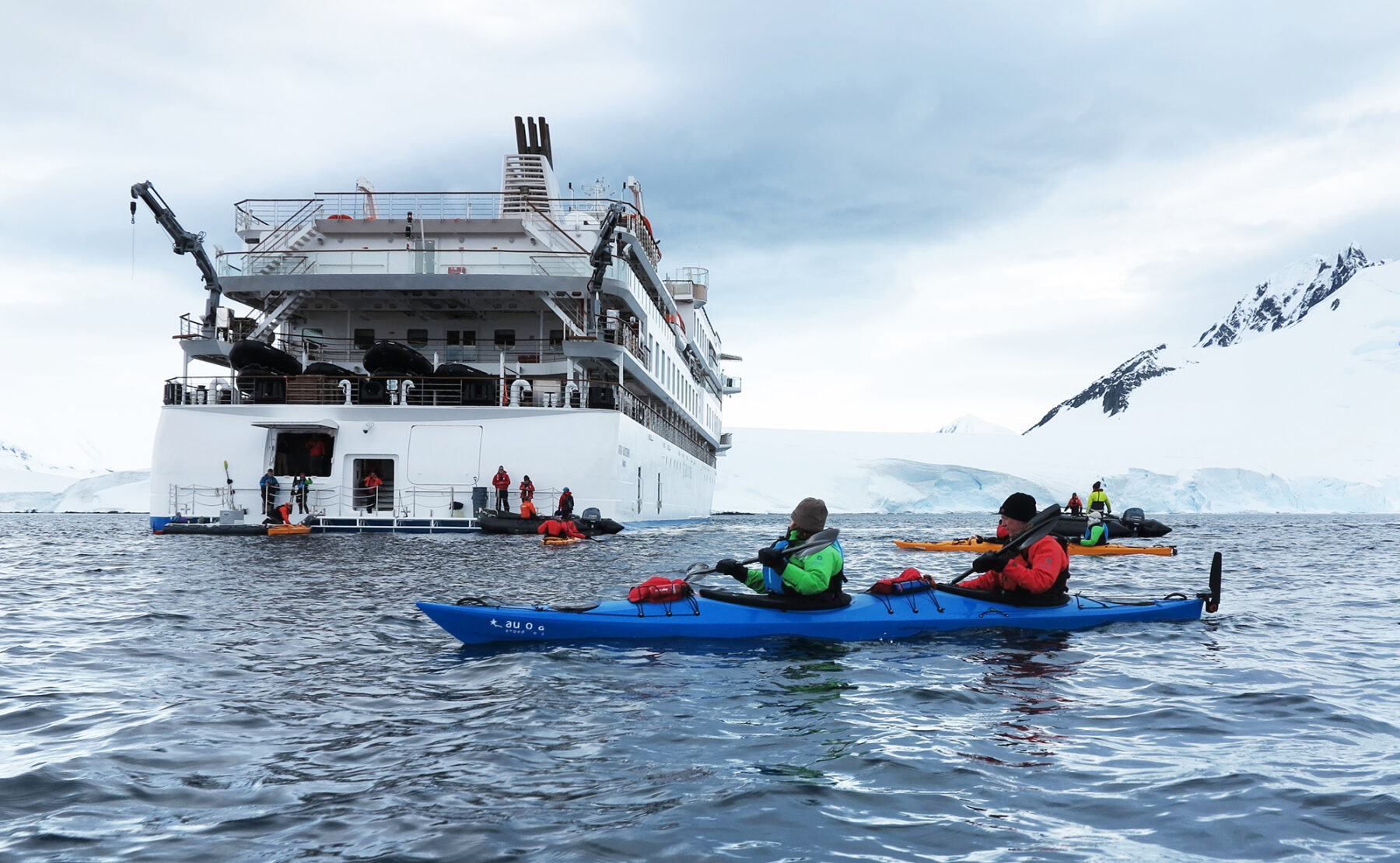
Come our first put-in, the anxiety is palpable. Most have never worn a dry suit before, an essential item for these frigid polar waters, and struggle with the tight gaskets and birth canal-like head aperture. The brand-new Gore-Tex Kokotat suits retail at roughly $1000 USD each, and a slew of other top shelf gear provided by Aurora includes solid 65° North Sea kayaks and US-made Austral PFDs. In their newness they match the ship itself – the Greg Mortimer is a state-of-the-art, ice-strengthened expedition vessel. The ‘mud room’, where we dress for each outing, is spacious, and the aft deck, where the boats are stored, cavernous. We also have the benefit of a custom-built floating loading platform which makes climbing in and out of the kayaks a breeze, and the opacity of the ship’s sunscreen makes everyone resemble Ghost Face Killah.
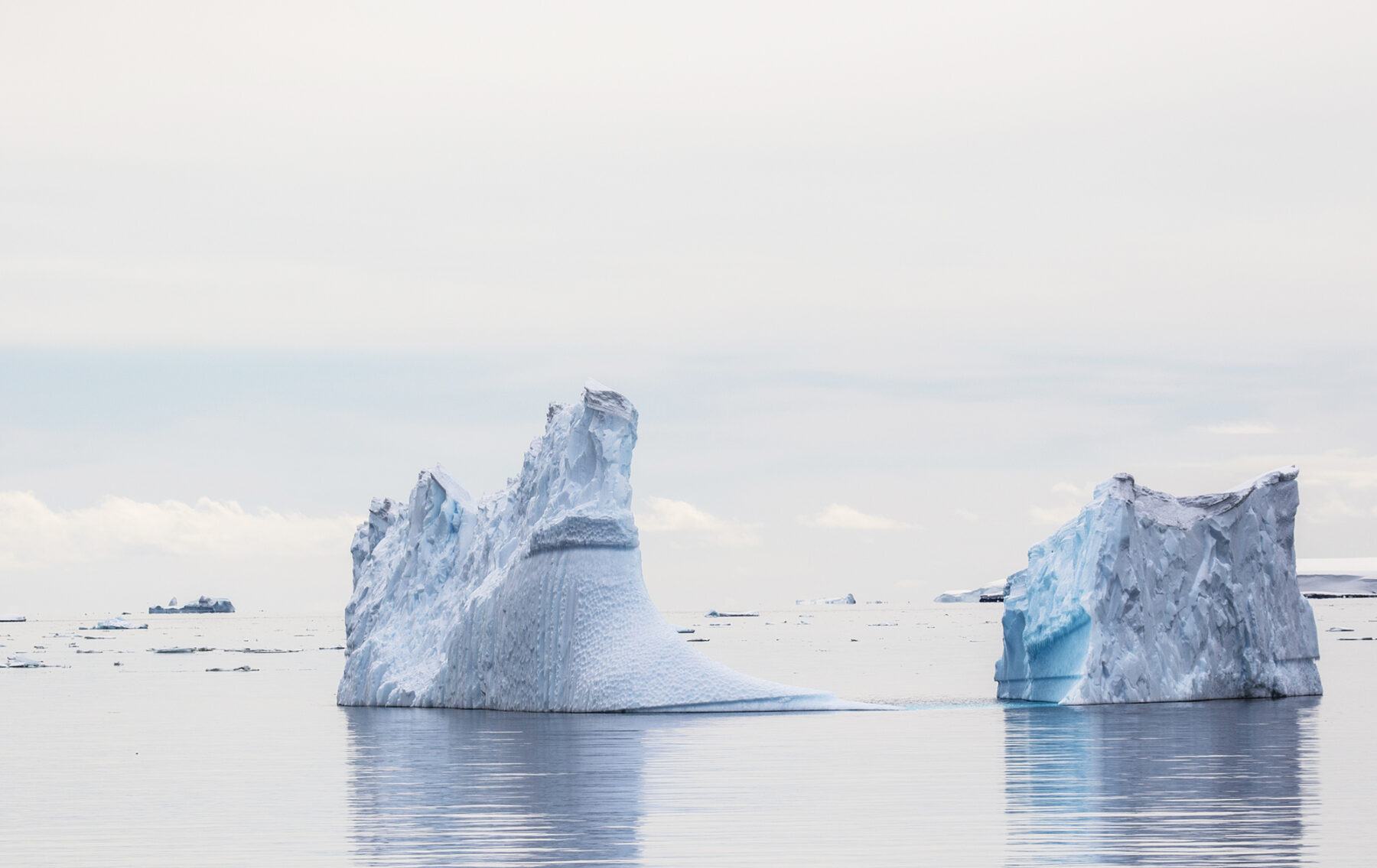
So far, so good, but once on the water, nature must provide the entertainment, and she doesn’t disappoint. The first location is Half Moon Island, a craggy outcrop of the South Shetland group, home to an important chinstrap penguin rookery. Overcast, with a chill wind, tensions in the flotilla are high. Well, at least until a humpback whale breaks the ice, as it were. Whales don’t have to be doing much to be impressive and this one is basically asleep. This means it lolls around on the surface obligingly while we gape at it from a safe distance.
“Once you spot a whale it’s fairly easy to determine where it’s going,” says Frank, one of the other kayak guides, when I ask him if a lairy blubber mammoth could conceivably breach into my lap. “So, if you put yourself in their way then yes, that can happen, but not if you’re paying attention and observe the rules.” The IAATO (International Association of Antarctica Tour Operators) set guidelines as to the distances vessels can approach marine wildlife, which for whales is 100m regardless of whether it’s a kayak or a cruise ship. “People always want to go closer,” continues Frank on the subject of balancing clients’ enjoyment with their safety, “but it’s in everyone’s best interest to observe the rules.”
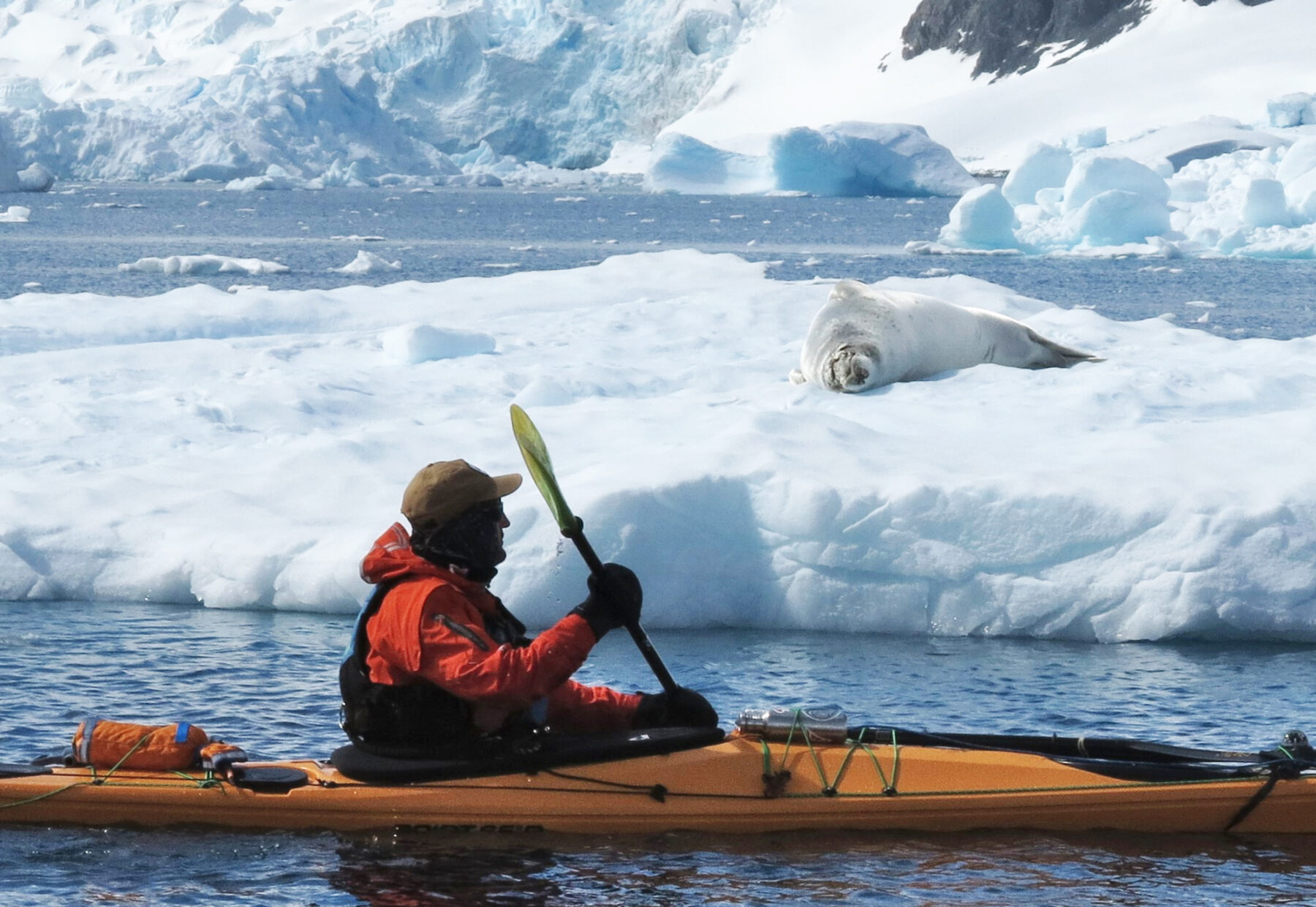
This adherence to the code and respect for the whales’ wellbeing is warmly received by the team, and that first encounter sets the bar pretty high for the coming days. The standard format, unless there happens to be an odd number of participants on any given day, is tandem kayaks all round, except for the guides, and this is accepted wholesale. A co-pilot makes the excursion more fun and helps us get to know our fellow adventurers as we chop and change partners like a Berlin swingers’ club. The only time anyone gets tipped in the drink is due to a rogue wave as one pair are re-entering after a beach landing. Even then they are only waist deep in the sub-zero water (saltwater freezes at a lower temperature than fresh water), and the dunking mostly serves to prove to all and sundry that the dry suits work.
A unique interruption to our regular programme
The kayaking programme aims for two excursions per day, weather dependant, while the regular passengers are occupied with Zodiac tours or shore landings. I’d been concerned that I might miss out on other cool stuff by always being paddling, or that I’d struggle to maintain my enthusiasm twice daily, but my fears were unfounded. The only time any of the kayakers miss a session is through bad weather, illness or a surprise marriage.
Yes, you read that right. On our first day anchored off the continent proper, a beautiful place called Neko Harbour, Barbara’s daughter Nat and her boyfriend Angus decide to tie the knot (presumably a bowline). “We organised with Aurora to have a secret ceremony some time on the trip when the weather was good,” reveals Nat, afterwards. “We just wanted a chance to get married on the mainland of Antarctica. It’s pretty unusual! So on that day Robyn (deputy expedition leader) came to us before lunch and said ‘Write some vows and we’ll see if we can make this happen.’ So we went and told the family: ‘Hopefully you don’t mind not kayaking this afternoon because we’re getting married today, so go and brush your hair.’ They were totally shocked!”
“It could have backfired,” chuckles Angus, “being stuck on a boat with angry in-laws for the rest of the week.” As Robyn isn’t a registered celebrant the couple were happy to make do with a commitment ceremony. (Contrary to popular belief, ship’s captains do not generally have the authority to officiate weddings.) Back in Australia, they’ll have to fill out the paperwork at the registry office to make it legal. “Just as Angus put the ring on my finger,” continues Nat, “a chunk of ice broke off one of the cliffs literally behind us and everything just stopped. It was so loud. I don’t know if that was a message from the Gods or what!”
The freedom of going with the flow
While Nat and Angus are starring in their own ‘Love among the icebergs’ mini-series, which come to think of it was probably cheaper than hosting an average wedding in Australia, the rest of us are hard at it. The prime location of the week, as agreed by all, is a spot called Paradise Harbour. It’s the first time the sun really comes out with enthusiasm, making the icebergs sparkle like broken windscreens. The mood of the whole group is jubilant and the seals seem to love it as well, as we see more giant, sabre-toothed slugs sprawled on ice floes than usual. We were actually unaware of the rarity of the sight for the non-kayakers until Ignacio brings it up. “I spoke to someone yesterday who was so excited to have seen a seal from the boat,” he tells us, “and I’m like ‘What do you mean, the place is full of seals!’”
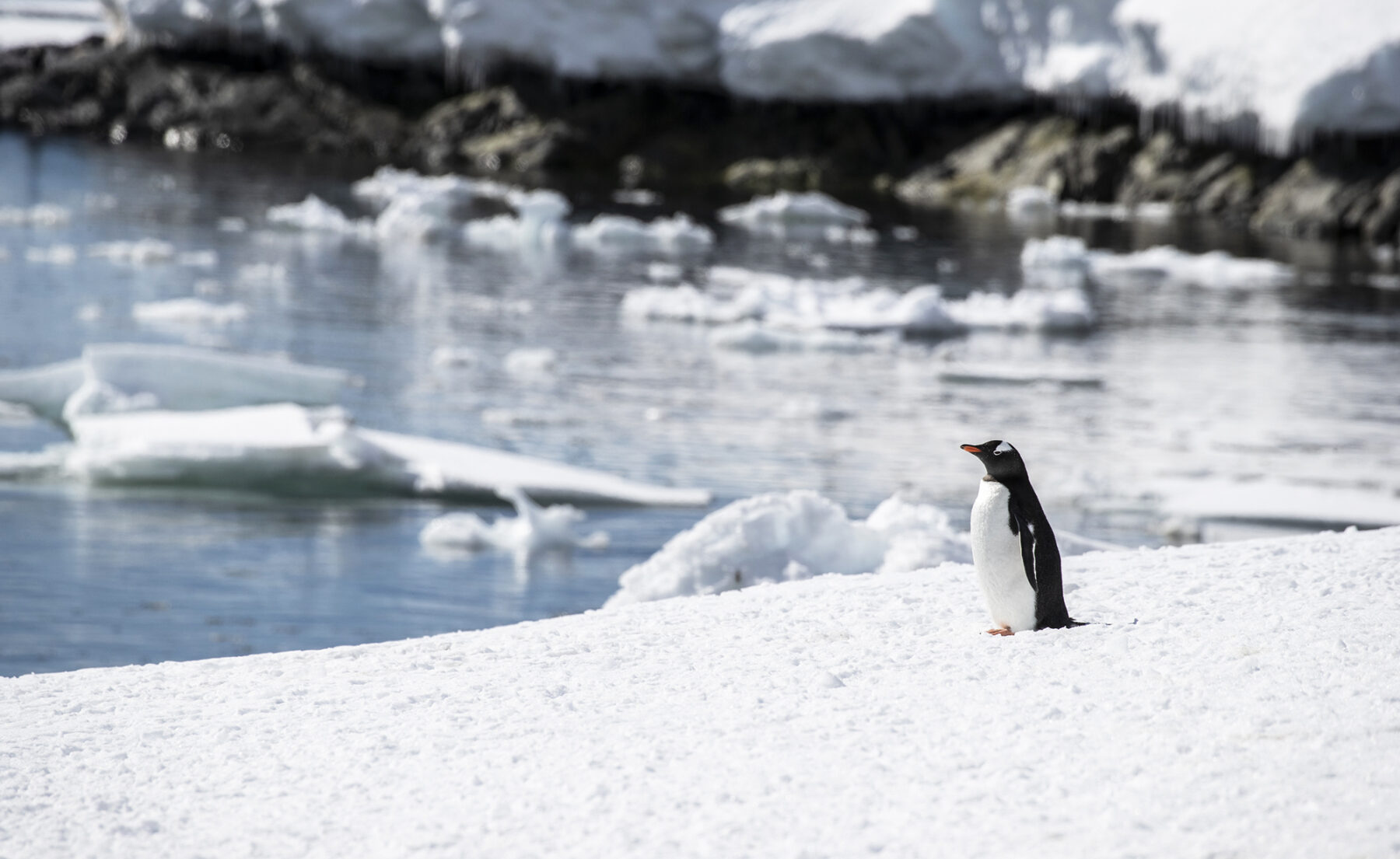
The same goes for swimming and diving gentoo penguins. One of my favourite sights is their graceful flight through the air as they boost themselves bodily out of the water, apparently the most efficient way for them to catch a breath while swimming. If you think they’re cute on land, ungainly and covered in their own filth (another thing they don’t mention in the brochure), they’re even better in mid-air, mirrored by their still reflection. You’d think they’d been adopted by a pod of dolphins and were copying their parents’ behaviour, unaware they were actually flightless birds.
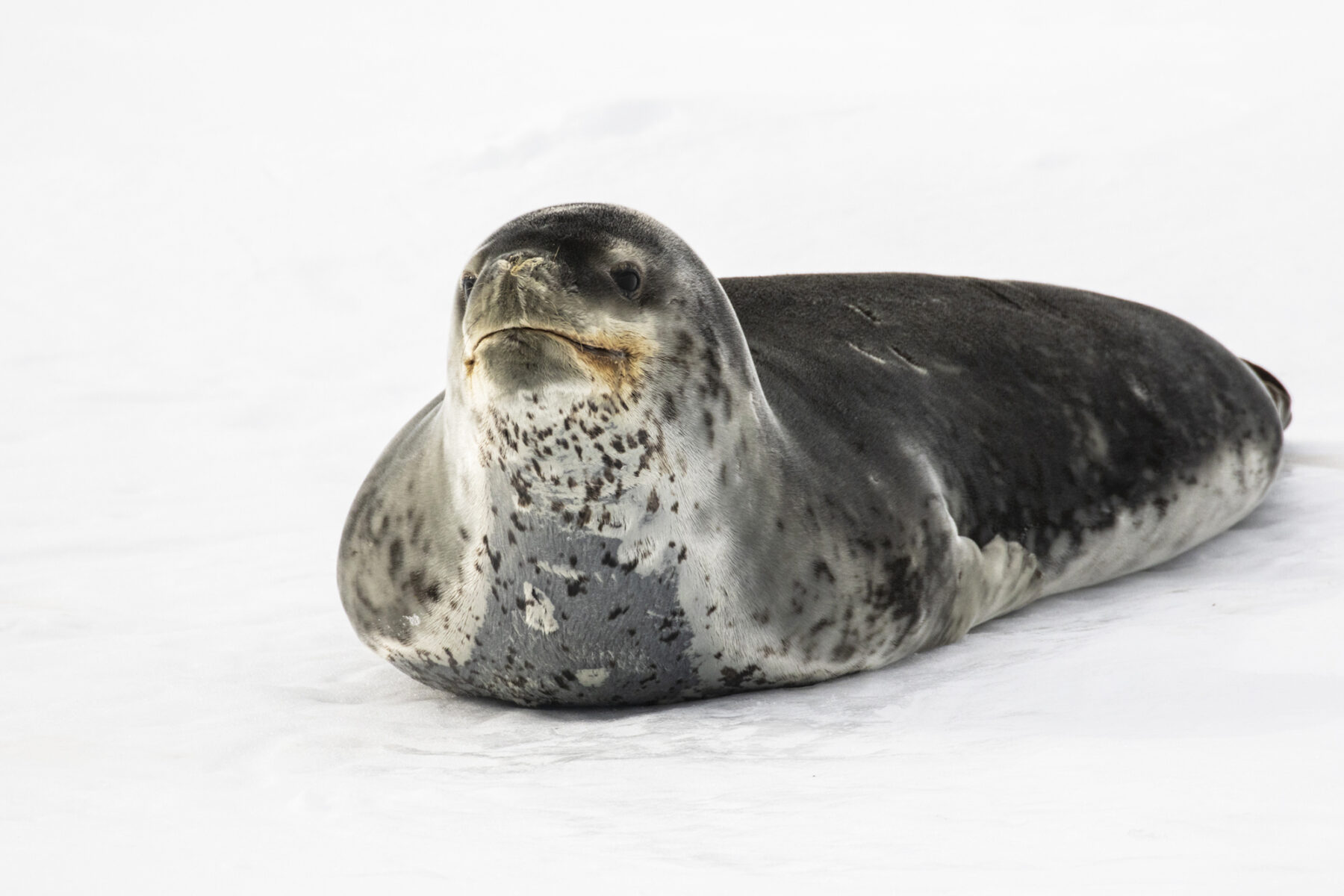
These examples serve to highlight the real joy of Antarctic kayaking – unrivalled proximity to wildlife and the freedom to explore. Inflatable Zodiacs carrying ten passengers, while a great experience, are noisier and sit lower in the water. Split into two small groups, we can basically paddle anywhere that takes our fancy. We still make shore landings but in separate spots to the Zodiacs, so ten of us have a whole cove to ourselves instead of sharing it with 100 pedestrians. “I love just creeping around,” confirms Nat. “Let’s just see what’s around this corner and ‘Oh look, there’s a leopard seal on the ice!’ The other day we went up a narrow channel, flat and shallow with sheer cliffs, and found a sailboat just hanging out there. It was beautiful.” Angus concurs: “There’s no way they would have got the Zodiacs in there, but we just paddled through.”
Capable hands encourage crazy ideas
Inevitably, there are a couple of days when the weather doesn’t co-operate, and an outing is called off. Even if we are all suited-up and ready on the aft deck, paddles poised, safety is paramount. On one occasion the swell rises to a disturbing three metres as we’re about to load. We can see the pontoon surging up and down, Frank’s head disappearing and reappearing with each wave, and are all silently thinking to ourselves that it may actually be a tad too rough for us. “Standing there looking at the water, I was kind of hoping they’d call it,” recalls Nat, later. “It wouldn’t have been fun.” Jeremy agrees. “I felt safe because they made the judgement and so I didn’t have to decide for myself whether or not to go in.” In the end we substitute a kayakers-only Zodiac cruise, landing on a pristine beach where we make snow angels and a human Christmas tree. It turns out to be a very enjoyable couple of hours that everyone tags as a highlight.

For me though, the icebergs entrance above all else. Whether shaped like a crenellated Moorish citadel or bristling like an albino dragon, their depth, poise and architecture never fail to catch and hold my eye. Having realised my paddling ambition of so long, it may be time set the bar a little higher. On my next trip south I’m going to ice-climb up the face of one of those multi-story monsters and BASE jump from the summit. Just don’t tell my mum.
